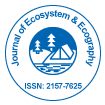Our Group organises 3000+ Global Conferenceseries Events every year across USA, Europe & Asia with support from 1000 more scientific Societies and Publishes 700+ Open Access Journals which contains over 50000 eminent personalities, reputed scientists as editorial board members.
Open Access Journals gaining more Readers and Citations
700 Journals and 15,000,000 Readers Each Journal is getting 25,000+ Readers
Google Scholar citation report
Citations : 2854
Journal of Ecosystem & Ecography received 2854 citations as per Google Scholar report
Journal of Ecosystem & Ecography peer review process verified at publons
Indexed In
- CAS Source Index (CASSI)
- Index Copernicus
- Google Scholar
- Sherpa Romeo
- Online Access to Research in the Environment (OARE)
- Open J Gate
- Genamics JournalSeek
- Ulrich's Periodicals Directory
- Access to Global Online Research in Agriculture (AGORA)
- Electronic Journals Library
- RefSeek
- Hamdard University
- EBSCO A-Z
- OCLC- WorldCat
- SWB online catalog
- Virtual Library of Biology (vifabio)
- Publons
- Geneva Foundation for Medical Education and Research
- Euro Pub
Useful Links
Recommended Journals
Share This Page
Diel cycle of the tropical air microbiome
Joint Conference International Conference on Environmental Microbiology and Microbial Ecology & International Conference on Ecology and Ecosystems
Elena S Gusareva
Singapore Centre for Environmental Life Sciences Engineering, Singapore
ScientificTracks Abstracts: J Ecosyst Ecography
Abstract
Our understanding of airborne microbial communities including their sources, functions, microbial interplay and ecology is limited despite its relevance for human health, environmental and ecosystems functioning. Few attempts have been made to study air microbial ecosystems to date. Tropical environments, distinct from temperate northern hemisphere systems studied so far, have specific physical/chemical features that impact the structure, function and ecology of the microbial components of their air ecosystems. Moreover, a highly urbanized ecosystem with its unique built environment and extensively processed indoor air, as encountered in Singapore, likely harbors defined yet unknown microbial communities. To comprehensively describe air-borne microbial ecosystem of Singapore, triplicates air samples were collected within 24 hours for 5 consecutive days in four independent experiments. We used filter-based high volume air sampling instruments to generate samples used for subsequent DNA extraction. A cultivation-free metagenomics next generation sequencing (NGS) was adopted to identify microbial taxa to species level. The air-borne microbial community was found to be remarkably stable with recurrence intervals of high microbial abundance in the dark hours and relatively low abundance in the light hours. Air samples were dominated by DNA of basidiomycota fungi and less frequently of Ascomycota fungi phylum. The microbial air ecosystem was mostly modulated by day/ night Biorhythms, temperature fluctuations and rain events. This is one of the highest-resolution researches currently undertaken on any air microbiome and its ecology, worldwide.Biography
Elena S Gusareva has evolved to be a researcher with a broad knowledge and experience in different aspects of biomedical science and biostatistics. Since joining the team of Prof. Schuster in 2016, she has been involved in a relatively new research field and project on the air microbiome aiming to study microbial diversity and ecology of urban air. So far, the results of the research efforts are remarkable and will certainly generate a series of downstream benefits, including improvements to public health, building design and management.

 Spanish
Spanish  Chinese
Chinese  Russian
Russian  German
German  French
French  Japanese
Japanese  Portuguese
Portuguese  Hindi
Hindi 
